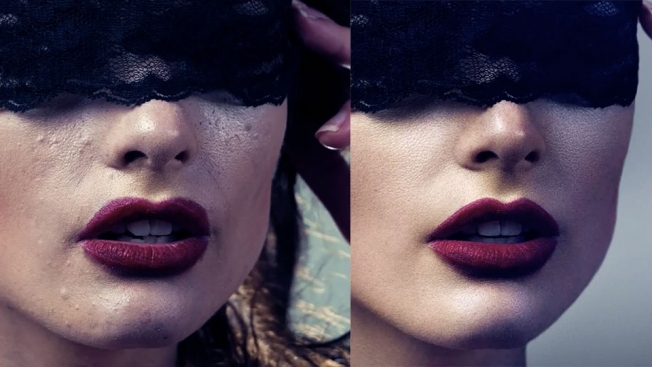
It's become conventional wisdom that Photoshopping of models creates an impossible standard of beauty. But one retoucher seems inclined to vindicate the process somewhat by peeling back the curtain on what really goes into it.
Rare Digital Art, a firm that's worked with top fashion magazines like Vogue and Vanity Fair and brands like Intermix and Yves St. Laurent, has created three 90-second time-lapse videos to show the painstaking work required to digitally polish a portrait.
The first video is arguably the most dramatic, purporting to capture six hours of retouching. Watch as Elizabeth Moss, Rare's founder, transforms the model bit by bit, making over her hair, skin, nails, fingers, nails, lips—even straightening her teeth. In the second—covering four hours of work—Moss thickens the model's hairline, and lightens her eyes (a fate spared the first subject, but only because she was wearing a blindfold). In the third, a mere hour and a half compressed, the model gets a new shape for her face.
The clips make for an impressive display of craft and a clever, lean-in sales pitch for a service that, right or wrong, is tangentially vilified by the popular narrative about positive body image (on which even large consumer brands like Dove are eager to capitalize). Moss tells PetaPixel she made them because "the quality of the other before-and-after retouching videos available online are pretty terrible and not at all representative of what is typically done on high-fashion editorials and campaigns."
She adds: "With all the talk about Photoshop use or overuse, I thought it would be interesting for people to see how we actually add pores to skin (we do this in the second and third videos, sampled from the girl in the first video)."
On one hand, it's a little thin to play off what's essentially an ad for her company as if it's a public-service announcement in defense of the profession. Adding what might be considered slight imperfections to an image in pursuit of making the whole a more emotionally manipulative facsimile of a real human doesn't exactly address the core criticism lobbed at excessive retouching—that, in the end, it distorts audiences' perceptions of themselves, and undermines self-esteem by showcasing ideals that don't reflect reality. (Then again, when do they ever?)
At the same time, probably by design, much of the work here seems harmless. Who, other than craftspeople, cares if the creatives change the hairstyle, lighting and lipstick color in postproduction rather than in camera? Other aspects do seem more bizarre. Is it really necessary to narrow the third model's cheeks so she looks more gaunt?
The answer, obviously, is somewhat subjective, and almost irrelevant. Even if it's worth questioning who gets to make the decisions about what defines beauty, and to challenge them with alternates, those decisions aren't about representations of truth. They're about selling fashion products, or selling magazines that are vehicles to sell fashion products.
Even if more and more people acknowledge that, and view media through that filter, appealing to vanity and base desire still seems like a pretty good way to make a buck.